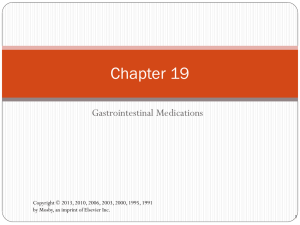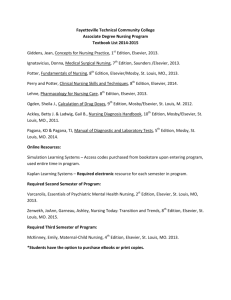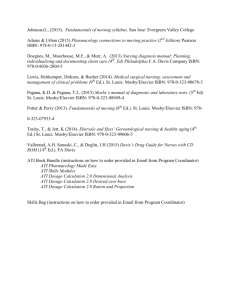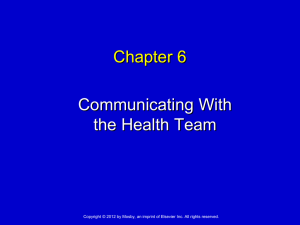Health literacy
advertisement
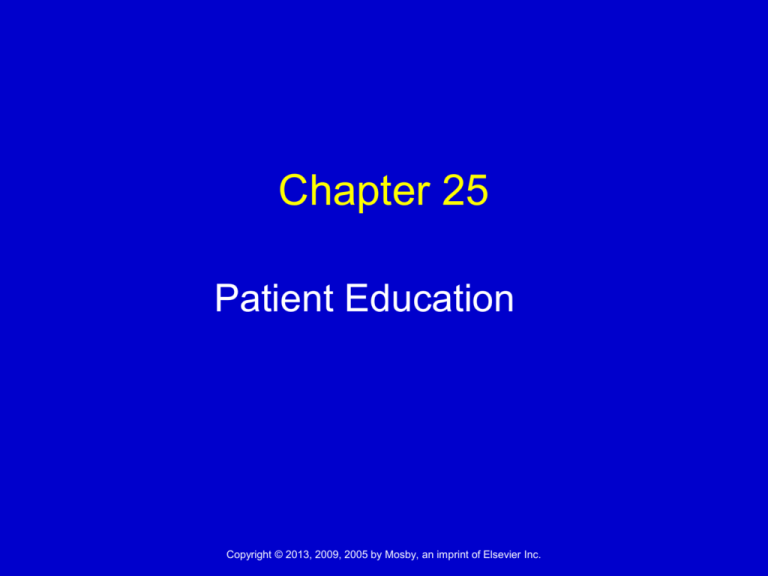
Chapter 25 Patient Education Copyright © 2013, 2009, 2005 by Mosby, an imprint of Elsevier Inc. Standards for Patient Education The Joint Commission sets standards for patient and family education. Successful accomplishment of standards requires collaboration among health care professionals. All state Nurse Practice Acts recognize that patient teaching falls within the scope of nursing practice. Copyright © 2013, 2009, 2005 by Mosby, an imprint of Elsevier Inc. 2 Purposes of Patient Education To help individuals, families, or communities achieve optimal levels of health Patient education includes: Maintenance and promotion of health and illness prevention Restoration of health Coping with impaired functioning Copyright © 2013, 2009, 2005 by Mosby, an imprint of Elsevier Inc. 3 Teaching and Learning Teaching An interactive process that promotes learning Learning The purposeful acquisition of knowledge, skills, behaviors, and attitudes Copyright © 2013, 2009, 2005 by Mosby, an imprint of Elsevier Inc. 4 Role of the Nurse in Teaching and Learning Teach information that the patient and the family need to make informed decisions regarding their care. Determine what patients need to know. Identify when patients are ready to learn. Copyright © 2013, 2009, 2005 by Mosby, an imprint of Elsevier Inc. 5 TJC’s Speak Up Tips Speak up if you have questions or concerns. Pay attention to the care you get. Educate yourself about your illness. Ask a trusted family member or friend to be your advocate. Know which medicines you take and why. Use a health care organization that has been carefully evaluated. Participate in all decisions about your treatment. Copyright © 2013, 2009, 2005 by Mosby, an imprint of Elsevier Inc. 6 Teaching as Communication Closely parallels the communication process Depends partly on effective interpersonal communication The learning objective describes what the learner will be able to accomplish after instruction is given. Copyright © 2013, 2009, 2005 by Mosby, an imprint of Elsevier Inc. 7 Domains of Learning Cognitive Includes all intellectual behaviors and requires thinking Affective Deals with expression of feelings and acceptance of attitudes, opinions, or values Psychomotor Involves acquiring skills that require integration of mental and muscular activity Copyright © 2013, 2009, 2005 Copyright by Mosby, line. an imprint of Elsevier Inc. 8 Quick Quiz! 1. A patient newly diagnosed with diabetes needs to learn how to use a glucometer. Use of a glucometer constitutes A. Affective learning. B. Cognitive learning. C. Motivational learning. D. Psychomotor learning. Copyright © 2013, 2009, 2005 by Mosby, an imprint of Elsevier Inc. 25 - 9 9 Domains of Learning Different teaching methods are appropriate for each domain of learning. Cognitive: discussion (one-on-one or group), lecture, question-and-answer session, role play, discovery, independent project, field experience Affective: role play, discussion (one-on-one or group) Psychomotor: demonstration, practice, return demonstration, independent projects, games Copyright © 2013, 2009, 2005 by Mosby, an imprint of Elsevier Inc. 10 Basic Learning Principles Motivation to learn Ability to learn Learning environment Addresses the patient’s desire or willingness to learn Depends on physical and cognitive abilities, developmental level, physical wellness, thought processes Allows a person to attend to instruction Copyright © 2013, 2009, 2005 Copyright by Mosby, line. an imprint of Elsevier Inc. 11 11 Slide Motivation to Learn • • Attentional set: the mental state that allows the learner to focus on and comprehend a learning activity Motivation: a force that acts on or within a person (e.g., idea, emotion, physical need) to cause the person to behave in a particular way Copyright © 2013, 2009, 2005 by Mosby, an imprint of Elsevier Inc. 12 Motivation to Learn (cont’d) Use of theory to enhance motivation and learning Self-efficacy: refers to a person’s perceived ability to successfully complete a task. Copyright © 2013, 2009, 2005 by Mosby, an imprint of Elsevier Inc. 13 Motivation to Learn (cont’d) Psychosocial adaptation to illness Difficult for patients to accept Need to grieve Learning occurs in the acceptance stage. Active participation Learning occurs when the patient is actively involved in the educational session. Copyright © 2013, 2009, 2005 by Mosby, an imprint of Elsevier Inc. 14 Ability to Learn Developmental capability Cognitive development Prior knowledge Learning in children Developmental stage Copyright © 2013, 2009, 2005 by Mosby, an imprint of Elsevier Inc. 15 Ability to Learn (cont’d) Adult learning Self-directed Patient-centered Physical capability Level of personal development Physical health Fatigue Copyright © 2013, 2009, 2005 by Mosby, an imprint of Elsevier Inc. 16 Learning Environment Well lit Good ventilation Appropriate furniture Comfortable temperature Quiet Private Copyright © 2013, 2009, 2005 by Mosby, an imprint of Elsevier Inc. 17 Integrating the Nursing and Teaching Processes The nursing process and the teaching process are not the same. The nursing process focuses on the patient’s total health care needs. The teaching process focuses on the patient’s learning needs and ability to learn. When education becomes part of the care plan, the teaching process begins. Copyright © 2013, 2009, 2005 by Mosby, an imprint of Elsevier Inc. 18 Nursing Process: Assessment See through the patient’s eyes. Teaching is patient-centered. Assess the patient’s learning needs. Ask questions to identify motivation to learn. Determine the patient’s physical and cognitive ability to learn. Provide an appropriate teaching environment. Assess the readiness and ability of a family caregiver or other learning resource. Assess health literacy/learning disabilities. Copyright © 2013, 2009, 2005 by Mosby, an imprint of Elsevier Inc. 19 Case Study Latinka Drusko is a 55-year-old Bosnian immigrant. She is overweight and is concerned about her health. She has come for her yearly physical. Ashley is a 23-yearold nursing student assigned to care for Latinka. During their first visit, Latinka states, “I am interested in getting some information to help me become healthier and lose some weight.” Copyright © 2013, 2009, 2005 by Mosby, an imprint of Elsevier Inc. 20 Nursing Process: Assessment (cont’d) Health literacy: the cognitive and social skills that determine the motivation and ability of individuals to gain access to, understand, and use information in ways that promote and maintain good health. Health literacy includes patients’ reading and mathematics skills, comprehension, and decision-making and functioning skills with regard to health care. Copyright © 2013, 2009, 2005 by Mosby, an imprint of Elsevier Inc. 21 Nursing Process: Nursing Diagnosis Nursing diagnoses for patient education Deficient knowledge (affective, cognitive, psychomotor) Ineffective health maintenance Impaired home maintenance Ineffective family therapeutic regimen management Ineffective self-health management Noncompliance (with medications) Copyright © 2013, 2009, 2005 by Mosby, an imprint of Elsevier Inc. 22 Nursing Process: Planning Determine goals and expected outcomes that guide the choice of teaching strategies and approaches with a patient: Set priorities. Select timing to teach. Organize the teaching materials. Use teamwork and collaboration. Copyright © 2013, 2009, 2005 by Mosby, an imprint of Elsevier Inc. 23 Nursing Process: Implementation Maintain learning attention and participation. Build on existing knowledge. Select teaching approach. Incorporate teaching with nursing care. Copyright © 2013, 2009, 2005 by Mosby, an imprint of Elsevier Inc. 24 Nursing Process: Implementation (cont’d) Select appropriate instructional methods: Group instruction One-on-one discussion Preparatory instruction Demonstration Analogy Role playing Simulation Copyright © 2013, 2009, 2005 by Mosby, an imprint of Elsevier Inc. 25 Nursing Process: Implementation (cont’d) Illiteracy and other disabilities Cultural diversity Using different teaching tools Special needs of children and older adults Copyright © 2013, 2009, 2005 by Mosby, an imprint of Elsevier Inc. 26 Quick Quiz! 2. During a teaching session, the nurse tells a patient with a recent neck injury that damage to the nerves is comparable to a water hose that has been pinched off. During this teaching session, the nurse is using the process of A. Analogy. B. Discovery. C. Role playing. D. Demonstration. Copyright © 2013, 2009, 2005 by Mosby, an imprint of Elsevier Inc. 25 - 27 27 Case Study (cont’d) Before she meets with Latinka again, Ashley decides to read about the Bosnian culture. Among other things, she learns that Bosnians tend to have strong ties with their families and communities. When they speak again, Ashley asks about Latinka’s community and learns that she is very close to her children and neighbors. Copyright © 2013, 2009, 2005 by Mosby, an imprint of Elsevier Inc. 28 Nursing Process: Evaluation See through the patient’s eyes. Have the patient’s learning needs been met? Evaluate a patient’s learning by observing performance of expected learning behaviors under desired conditions. Discontinue, adjust, or amend the plan. Patient outcomes: Legal responsibility Documentation Copyright © 2013, 2009, 2005 by Mosby, an imprint of Elsevier Inc. 29

